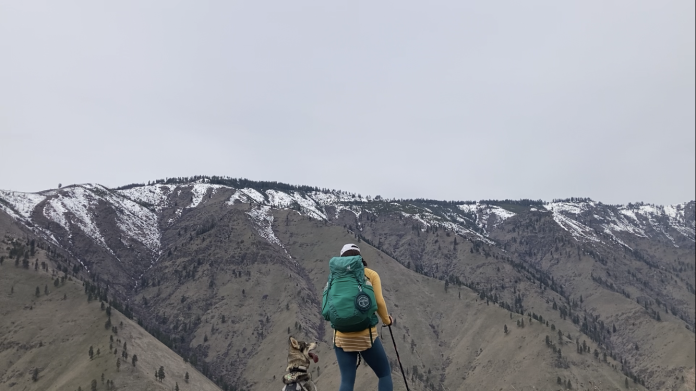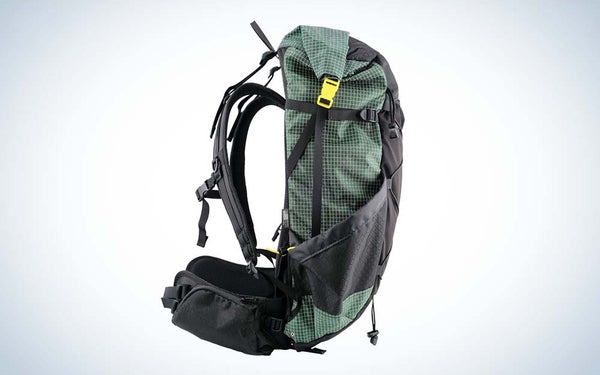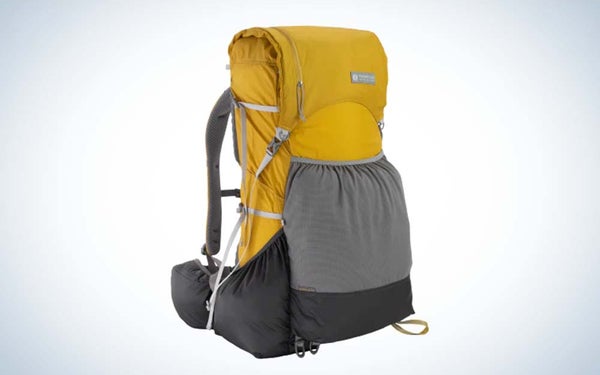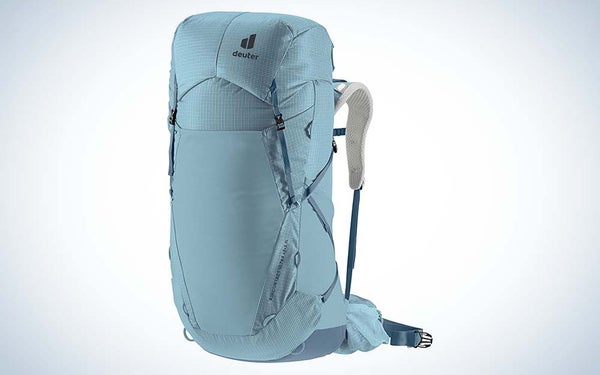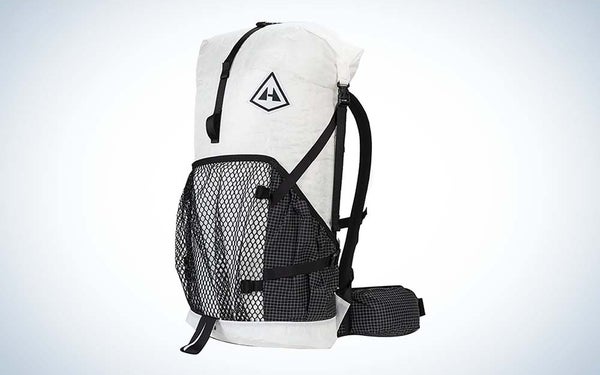We may earn revenue from the products available on this page and participate in affiliate programs. Learn more ›
Published Apr 17, 2023 1:17 PM
The best ultralight backpacks have a large enough capacity to carry all your essentials, are comfortable to wear for hikes of all distances, and are durable enough to last several seasons on the trail. While not everyone needs an ultralight backpack—some hikers would be fine with a traditional backpacking backpack that may weigh a few extra pounds—they’re a game-changer for hikers who travel long distances, do endurance hikes, or seek lightweight, efficient gear for frequent backpacking trips.
I am not trying to convince anyone not to get an ultralight backpack, but I want to express that they are optional for the average hiker to enjoy their outdoor adventures. Ultralight gear is often a larger monetary investment and can have slightly lower durability. Luckily, as our fabric technologies advance and product design develops, focusing on lighter gear, comfort, and durability has also improved. Below we’ve tested some of the best ultralight backpacks and ranked them on those features.
How We Picked the Best Ultralight Backpacks
For this guide, we consulted with industry experts, product developers, and ultralight enthusiasts to get their opinion on the best backpacks and then combined that with firsthand product experience. During the testing and research process, I did my best to narrow down the selection of options to fit specific needs and separate them into categories.
When selecting the best ultralight backpacks, we also considered the following:
- Durability: What is the product lifespan? Are the materials durable? How sturdy is the stitching? Is there a product warranty or repair policy?
- Comfort: Is the backpack comfortable to wear for extended hikes? How does the pack distribute weight? How adjustable is the pack? What are the suspension, ventilation, and padding like?
- Features: How is the backpack organized? Are there any features that enhance the product experience? Do the features fit my adventure needs?
- Sustainability: How transparent is the company about product sourcing and manufacturing processes? What is my projected frequency of use? Is a sustainability report available?
As further gear testing occurs or new products enter the market, products are subject to change, and descriptions may be updated. Updates about durability are likely, so check back for updated recommendations.
The Best Ultralight Backpacks: Reviews and Recommendations
Best Overall: ULA Circuit
Specs
- Materials: 100% Robic Nylon fabric, Teflon DWR, PU Coating, carbon fiber and Delrin suspension hoop, internal foam frame, aluminum stay
- Capacity: 68L
- Weight: 2.3 lbs
- Max Load: 35 lbs
Pros
- Made in the USA
- Lifetime warranty and repairs
- Customizable fit and features
- Fits any bear canister on the market
- High level of comfort
Cons
- Heavier than other ultralight pack designs
- Roll top closure could be more secure
Voted the most popular backpack on the Pacific Crest Trail for the past three years (Halfway Anywhere Annual Survey of PCT Thru-Hikers), the ULA Circuit is an ultralight backpack that seemingly has it all. This is a hard pack to beat, designed with surprisingly durable materials, a lifetime warranty, and a promise of tune-ups and repairs. Across the board, the ULA Circuit is known for its comfort on long-distance hikes, which may be partially due to the custom sizing and fit the brand offers upon purchase.
The advised maximum load-carrying capacity is 35 pounds, which is large enough for many backpackers to pack all the necessary basics. This pack also has an extension collar for additional storage required for colder weather or extended trips with more food. The bag is standard to pack with a top-loading roll top. Although this is efficient, the closure for the roll top can be challenging to latch at times and isn’t as secure as some cinch designs. There are a few exterior pockets that work well for stuffing and have a shocking amount of room. When carrying the bag within the recommended weight or lower, it offers a high level of comfort and feels very balanced. The pack is designed with an internal foam frame and aluminum stay, improving overall weight transfer and control. Even when fully loaded, you shouldn’t feel this backpack limits your range of motion on the trail.
Most Comfortable: Gossamer Gear Gorilla 50
Specs
- Materials: 70 denier Robic ripstop nylon, 100 denier Robic nylon, mesh fabric
- Capacity: 40L
- Weight: 1.9 lbs
- Max Load: 30 lbs
Pros
- Durable materials
- Excellent load-carrying comfort
- Large exterior pockets
- Versatile and adaptable use
- Functional features
Cons
- Not all bear canisters fit
- Not a lot of options for attaching gear to the outside of the pack
The Gossamer Gear Gorilla 50 is an ideal balance of comfort and functionality in the world of ultralight backpacks. It is just under two pounds (1.9 pounds) at the measured weight but can be stripped down to 1.7 pounds. The interior capacity is optimized to carry a traditional amount of gear needed, but it may only be comfortable to carry some bear canister designs. The addition of the exterior mesh pockets adds a decent level of carrying capacity, making it even more functional for a variety of hiking trips.
Some hikers may even use this pack for day hikes, but it is also quite comfortable for backpacking trips when carrying 30 pounds or less. When carrying light loads, you can remove the frame and hip belt. For ideal comfort, we recommend sticking closer to 25 pounds with this pack, but it offers excellent comfort and a weight-to-volume ratio across the board. The shoulder straps are padded, and the weight transfer to the hip belt is optimal. When the pack is loaded, it doesn’t create pressure points or cause any potential hot spot issues because of the weight distribution.
While the external mesh pockets offer additional storage outside the main compartment, there are few places to attach gear to the outside of the pack (features lashing for ice axe and trekking poles). It would be possible to attach your cords to the outside if you felt it was necessary but depending on what you’re attaching, it could throw off the weight distribution.
Best for Women: Deuter Aircontract Ultra
Specs
- Materials: 175D Polyamide Ripstop Ultra HD, PFAS Free
- Capacity: 45 + 5L
- Weight: 2.6 lbs
- Max Load: 35 lbs
Pros
- Deuter Lifetime Warranty
- Bluesign-certified backpack materials
- Exterior attachments for additional gear
- Customizable design
- PFAS free
Cons
- Heavier than other ultralight models
The Deuter Aircontact Ultra is our pick for the best women’s ultralight backpack. While some may argue that it doesn’t fit within the ultralight category, the weight-to-volume ratio and level of comfort made it suitable for inclusion on this list. The low-weight profile is excellent for a lightweight backpack and has an optimal organization for short backpacking trips and beyond. Packing the primary compartment is easy, and since the pack lid is removable, it is nice that the cinching is secure to hold contents in place.
Although you’ll likely have plenty of space inside the pack for necessary equipment, the exterior pockets and straps allow for external gear storage. The compression straps can be manipulated to either strap things to the side (i.e., trekking poles) or to the front outside of the mesh panel. The lid and strap buckles are tiny, and I did have some concerns about the durability. They are easy to use and adjust, but if you are wearing gloves, it isn’t easy to open and close them. The weight distribution is adequate when the pack is under the max load weight capacity, and I noticed minimal load shifting while hiking. With some adjusting, it was easy to fit the backpack to my body, and it was comfortable on varying, steep terrain. I find it challenging to find a proper fit for some backpacks because I have a long torso and broad shoulders for a woman. This pack seems adjustable enough to be comfortable for various body types. During testing, my pack was around 30 lbs and even close to the max load capacity, the pack is comfortable to carry, and the weight sits primarily on the hips instead of the shoulders.
The backpack is standard to load with gear. The cinch closure and top-loading design are typical of many backpacking backpacks. I did wish there was a sleeping bag pocket on the bottom to make packing and unpacking easier, but with the capacity of this bag, that wasn’t much of a concern. The water bottle holder design was hard to access while wearing the pack, and it would be nice if that were more accessible. It isn’t the lightest pack on the list, but it seems durable, fits most women’s bodies quite well, and offers versatility as a lightweight backpacking option for year-round adventures.

Most Durable: Hyperlite Mountain Gear Junction
Specs (white)
- Materials: Dyneema Composite Hybrid 50D and 150D, Mesh
- Capacity: 55L
- Weight: 2 lbs
- Max Load: 40 lbs
Pros
- Durable materials on side pockets
- Mesh panel is great for drying wet gear
- Roll top for additional pack compression
- Stays can be removed and bent to fit body shape
- Versatile for varying climates and terrain
Cons
- The hip belt is sewn in and not removable
- Shoulder straps are not the most comfortable
- The white pack color gets dirty easily
Made from highly durable Dyneema composite materials, the Hyperlite Mountain Gear Junction 3400 is one of the most durable ultralight backpacks. This brand has several other backpack designs very similar to the Junction but with some varying features. This one is the most versatile in varying climates and terrains thanks to a mesh panel on the front to dry wet gear and Dyneema panel side pockets for optimal durability when off the trail.
The hip belt and shoulder straps are sewn into place, which can be seen as either a pro or a con. I recommend pulling the pack closer to your hips to provide a more balanced weight distribution and push more of the weight to sit on your hips instead of your shoulders. The discomfort from the shoulder straps could be partially due to the lack of external load lifters, which the company didn’t feel were necessary for this pack. Still, the shoulder strap design could be improved to be more comfortable for long-distance hikes. You can adjust the fit of the pack with the removable frame stays, which come pre-bent but can be bent and fitted to fit your body properly. If you’re carrying a load under the recommended weight, you shouldn’t have too much of an issue with weight distribution, but as you get closer to or surpass the max load weight, the pack becomes more uncomfortable.
Best Value: Osprey Exos 48
Specs
- Materials: Bluesign® approved recycled 100D high tenacity nylon ripstop, PFC/PFAS-free DWR
- Capacity: 48L
- Weight: 2.7 lbs
- Max Load: 30 lbs
Pros
- Made with 100% recycled materials
- Adjustable suspension
- Osprey Lifetime Warranty
- PFAS-free DWR
- Excellent ventilation
Cons
- Water bottle side pockets are hard to access while the pack is on
The Osprey Exos 48 is an excellent mid-sized lightweight backpacking pack option. It has a max load weight of about 30 pounds, and once you reach that weight, the backpack will only support the weight well. Follow the manufacturer’s recommendations to avoid discomfort while hiking with any ultralight pack. For the price, it is hard to beat the quality of an Osprey pack, which is primarily known for its durability. This pack offers a lightweight option suitable for ultralight backpacking trips. If you’re familiar with Osprey backpacks, you’ll recognize many similar features and qualities, like the airspeed suspension and optimal ventilation for hiking in warm conditions.
The pack’s fit is adjustable and comfortable for men and women of varying body sizes. The mesh materials and seams have been improved for durability to make this pack suitable for long-distance hikes and weekend trips. When fitted correctly and packed within the load range, this pack provides excellent weight distribution and comfort on the trail. Like all Osprey packs, we wish the water bottle side pockets were more convenient. The size of this pack makes it doable to take the water bottle out while wearing it, but it is near impossible to put the bottle back without taking your pack off.
While this isn’t necessarily a budget backpack, it is an excellent value at a lower price than many other ultralight options. Osprey offers a lifetime warranty and repair options, even if you buy the pack used.
What to Consider When Choosing an Ultralight Backpack
Intended Use
Before deciding on the best ultralight backpack for you, it is essential to identify the right fit for your needs. When choosing any form of backpacking pack, knowing how you plan to use the backpack helps narrow down your options.
Ultralight backpacks are ideal for hikers who want to go long distances carrying minimal gear, or who are traveling across trails on a speed or endurance track. Most average hikers can get away with more traditional backpacks that offer a higher level of comfort and durability (and often a lower price). Big game hunters would be advised to shy away from ultralight designs and should opt for hunting-specific backpacks as their pack weight can change, and carrying out additional weight would not only be uncomfortable but can wear on the pack design. Still, many ultralight backpacks offer features that backpackers in many disciplines enjoy.
The backpack’s size, comfort, and features that best suit your desired hiking experience reflect your intended use and often the frequency of use. If you’re a backpacker who only goes on one trip a year, you not necessarily need to invest in entirely ultralight equipment. However, if you go on various trips with distance goals and want to minimize weight in any way possible, you’ll benefit more from an ultralight setup. That’s not to say that not everyone could be happy with an ultralight backpack but to say that they aren’t necessary for all backpacking scenarios.
Knowing your budget can also influence these decisions. Before jumping into the other considerations, I’ve always found it helpful to identify both the intended use and frequency of use. That way, you can find a backpack suitable for the type of terrain, the distance, and the climate, suits your preexisting gear, and has the comfort level of your preference.
Comfort
Although the focus of an ultralight backpack is the weight, it also needs to be comfortable under the loaded weight of our gear. Most hikers hitting the trail with an ultralight backpack carry anywhere from 15 to 30 pounds. Some ultralight backpacks may be able to carry more weight physically, but they may not be as comfortable under a heavier load.
There are ways that ultralight hikers can strip down the weight of the pack, if you’re on a short trip or if you have super ultralight gear. When stripping a pack for weight, you can remove the waist belt, internal frame, and other components, depending on the brand.
The frame and pack construction can impact how comfortable it is across different weight loads. For example, packs made by Osprey tend to have a stiffer back panel and more padding, making them less comfortable with lighter loads. So consider the base weight when looking for an ultralight backpack. If you’re on the higher end of the weight, a pack like the Osprey Exos 48 might be an excellent choice, but if you’re closer to 12 to 20 pounds, backpacks that can more easily be stripped down or don’t have a tensioned frame are a more comfortable option.
Volume
The volume of the pack reflects the capacity. When it comes to pack capacity, look at the overall weight-to-volume ratio, a.k.a. how much the pack can carry in relation to its weight. The capacity of backpacks only includes what can be carried inside the backpack. Many ultralight backpack designs feature several ways to attach gear to the pack’s exterior. When discussing volume, we only discuss the main compartment, exterior pockets, and backpack lid. Some pockets, the lid, straps, and frames can be removed from ultralight backpack models to adjust and reduce weight when necessary, impacting the overall volume.
Knowing how much room your base weight gear occupies within a backpack helps you know which capacity bag is appropriate for your hiking needs. The best ultralight backpacks are highly versatile and have some adaptability according to the type of gear being carried. The weight-to-volume ratio can also tell you how suitable an ultralight pack is to carry heavier loads. Ultralight bags with higher capacities should also have a higher level of comfort.
Like other backpacking backpacks, ultralight backpacks measure volume in liters (some in cubic inches, but that’s less common).
Standard ranges for backpack sizes include:
- Overnight Packs: 35L or less
- Weekend Packs: 35-50L
- Multi-Day Packs: 50-75L
- Big Game Hunting Packs: 50L or more
- Winter Multi-Day Packs: 75L or more
The ranges listed above are for all backpacking packs. Most ultralight backpacks range from 30-65L, but most likely, they will be less than 50L in most cases. If you are building an ultralight backpacking kit, we recommend purchasing all your other gear before investing in a backpack. Having the base weight of equipment on hand gives you a better idea of the size and weight-to-volume ratio necessary.
Durability
An ultralight backpack’s durability is surprisingly high if used for its intended purpose. If you frequently head out with loads over 30 pounds in an ultralight pack, the weight will degrade the materials and frame much faster than utilizing the ultralight focus of the bag appropriately. We cannot say that an ultralight backpack is as durable as a standard backpack weighing 3 to 6 pounds. Those backpacks use stronger and more durable materials because they’re designed to withstand carrying heavier weights.
Ultralight backpacks can be durable and long-lasting if they are used within their intended load range, are cleaned often, and stored correctly (and if you perform other maintenance as needed). Most ultralight backpacks should last at least the length of well-known thru-hikes like the AT or the PCT. The best ultralight backpacks should last much longer than that and have the potential to be your primary backpack for several years and thousands of trail miles.
Since ultralight backpacks reduce the number of additional features and zippers, they often require less maintenance. The primary aspect that contributes to the bag’s durability is the material of the main pack body and any exterior pocket fabric. Mesh, no matter the type of pack it is on, is a less durable material and can quickly develop holes or snags. The fabric’s denier indicates how durable it is (remember, the higher the denier number, the stronger the material).
The frame can also have some durability concerns. Some ultralight backpacks utilize carbon fiber frames to cut weight, but if you are concerned about durability, opting for a pack with an aluminum frame may be beneficial.
In the end, we acknowledge that ultralight gear has some trade-offs, one of which can be durability. However, I’ve found that ultralight gear can last just as long if treated with care. Pay attention to how the pack is stored. Don’t just toss the bag into the back of your truck after a hike, and avoid overstuffing the pockets. These little things all cause wear; over time, they can degrade the pack enough to make it no longer functional in the field.
FAQs
Q: Are ultralight backpacks worth it?
Ultralight backpacks can be worth it for the right hikers. If you only do a few trips a year and aren’t aiming to set a speed record or go a long distance, ultralight gear isn’t usually necessary. Finding a comfortable backpacking backpack should be a priority, and if that pack happens to be ultralight, great! For thru-hikers, endurance hikers, and other long-distance ventures, an ultralight pack can be a good investment but still isn’t necessary for success or comfort on the trail.
Q: How do I pack an ultralight backpack?
Packing an ultralight backpack is similar to packing a traditional backpacking pack. To help distribute weight more evenly, we recommend stacking gear in horizontal layers instead of in vertical segments. Heavier equipment should be lower in the pack to prevent load shifting, and consider packing gear in waterproof bags or lining the backpack with a trash liner or trash bag. Some backpacks may be waterproof, but most ultralight bags are made from materials with minimal waterproof properties, so a rain cover or other waterproofing is necessary.
Q: How big should an ultralight backpack be?
Ultralight backpackers tend to have smaller backpacks because they carry less gear. A savvy packer can get away with an ultralight back in the range of 40-55L; some ultralight hikers may even carry a bag as small as 35L. Traditional backpackers are more likely to have a bag ranging from 55-65L, and some ultralight bags do come in larger capacities but may not be as comfortable to use while carrying a heavy load.
Q: What is ultralight vs. lightweight backpacking?
Ultralight versus lightweight (and super ultralight) definitions revolve around the measurements of the base backpack weight. A lightweight backpacker generally has a base weight of around 20 pounds, an ultralight packer will be closer to 10 pounds, and super ultralight hikers carry a base weight of 5 pounds or less. The base weight of a backpack is the weight of your standard backpack plus the gear minus any consumables (food, water, fuel). Consumables are any items you use during the trip that decrease in weight and volume.
Q: How do I know if my backpack is too heavy?
A loaded backpacking pack should weigh at most 20 percent of your body weight. A day hiking pack should be at most 10 percent of your body weight. You can tell if a backpack is too heavy if it throws you off balance while you are hiking, you may become fatigued much faster, dehydration sets in quickly, you lean too far forward while walking, the pack height is above your head, and the general discomfort of wearing the backpack is high. These factors can also be influenced by packing a backpack improperly, your body size, or lack of physical fitness for the terrain and distance.
Final Thoughts on the Best Ultralight Backpacks
The best ultralight backpacks are designed to carry an average base weight of 10 to 20 pounds. Carrying a heavy load with an ultralight backpack isn’t common, so remember that these packs are often more comfortable at a lower weight. The backpacks we feature on our list are options backpackers of all ability levels can use and would likely be happy with on various types of hikes. We encourage investing in a backpack that you feel not only reflects your intended use but also has a quality build, and the company offers a lifetime warranty and repairs. Even with durable products, with extensive outdoor use, the damage is bound to happen. Make the most of your purchase by investing in a product that will last a lifetime on the trail.
Why Trust Us
For more than 125 years, Field & Stream has been providing readers with honest and authentic coverage of outdoor gear. Our writers and editors eat, sleep, and breathe the outdoors, and that passion comes through in our product reviews. You can count on F&S to keep you up to date on the best new gear. And when we write about a product—whether it’s a bass lure or a backpack—we cover the good and the bad, so you know exactly what to expect before you decide to make a purchase.

